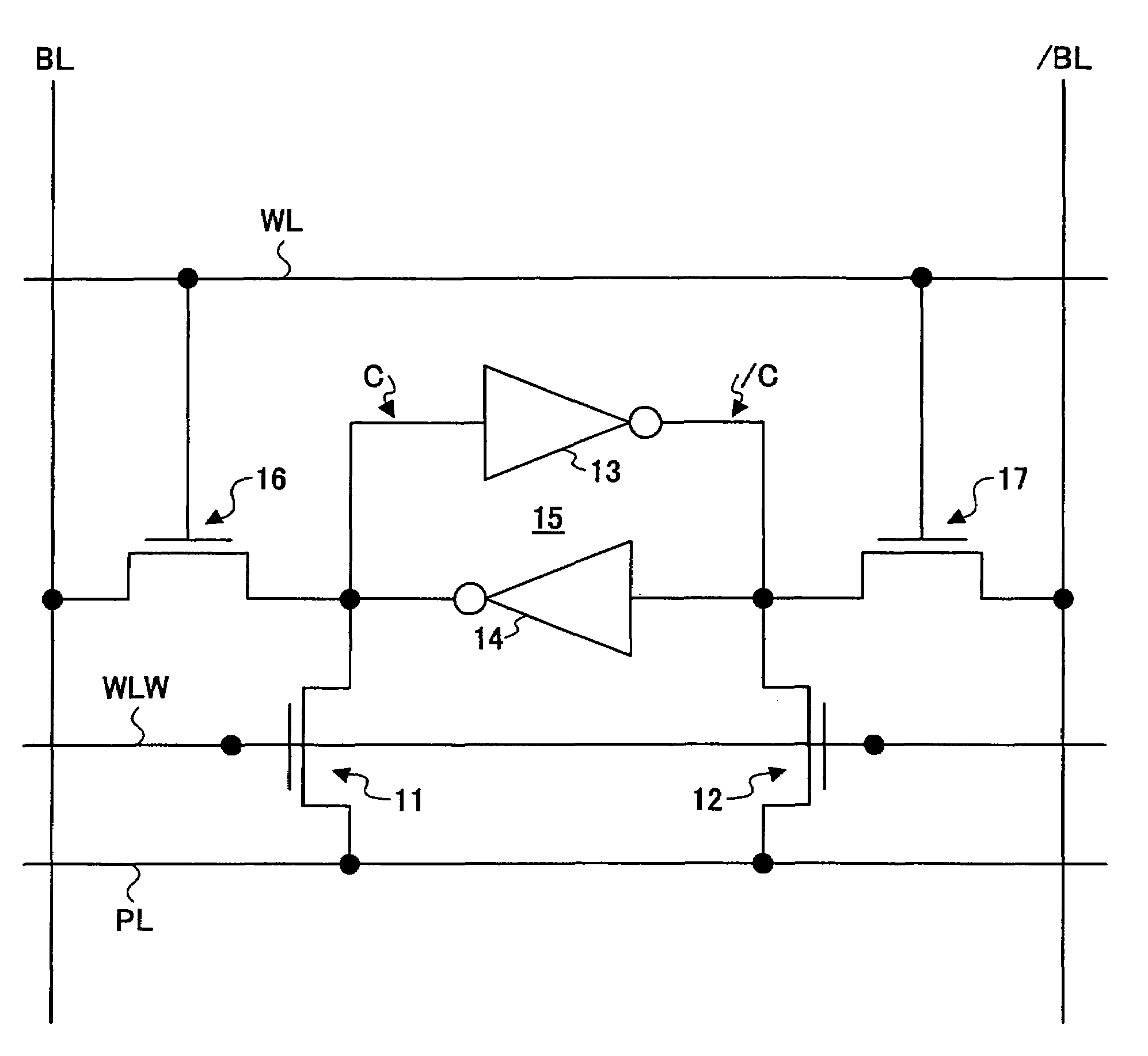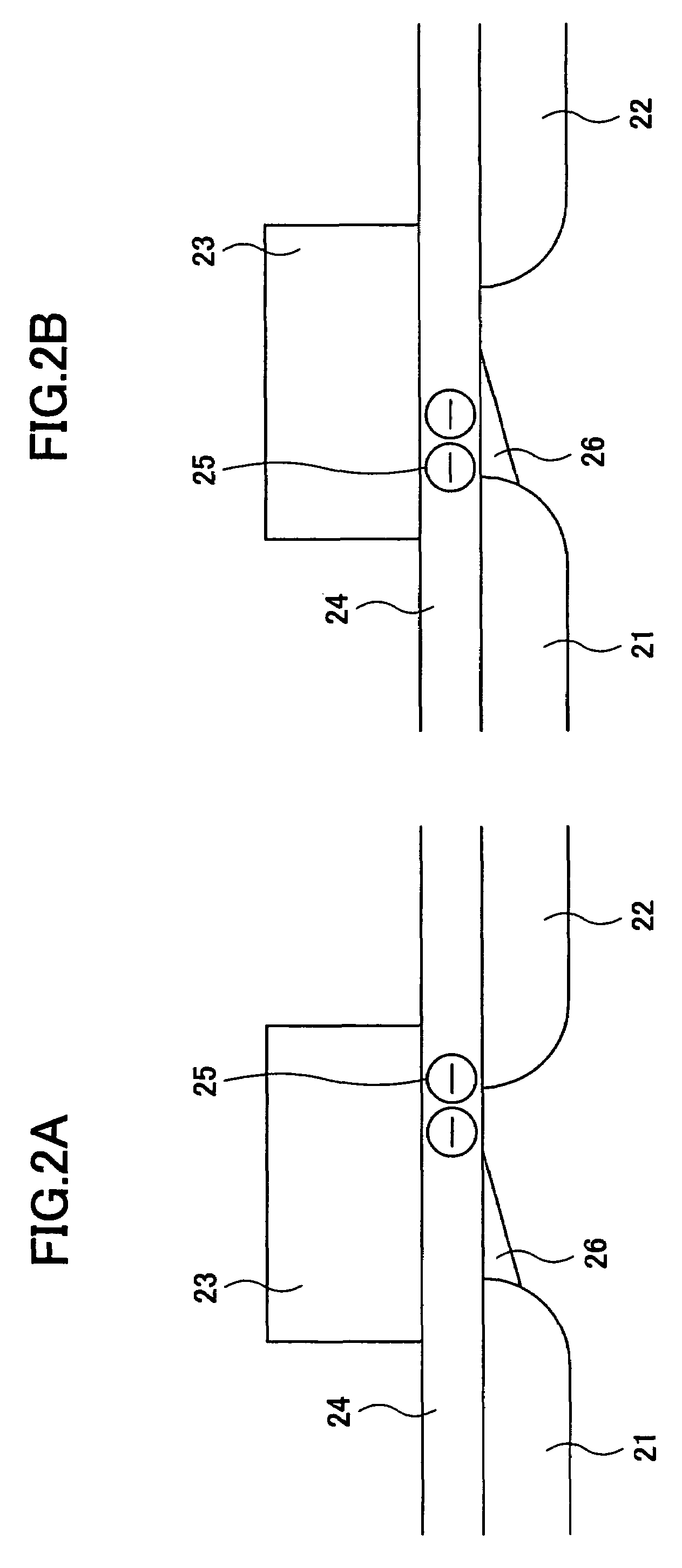Nonvolatile memory utilizing asymmetric characteristics of hot-carrier effect
a technology of hot-carrier effect and non-volatile memory, which is applied in the field of memory circuits, can solve problems such as increasing manufacturing costs, and achieve the effect of efficient us
- Summary
- Abstract
- Description
- Claims
- Application Information
AI Technical Summary
Benefits of technology
Problems solved by technology
Method used
Image
Examples
first embodiment
[0075]FIG. 4 is an illustrative drawing showing the configuration of a memory cell according to the nonvolatile memory device of the present invention.
[0076]The memory cell includes NMOS transistors 51 and 52, a PMOS transistor 53, NMOS transistors 54 through 56, PMOS transistors 57 and 58, and NMOS transistors 59 and 60. The NMOS transistors 54 and 56 and PMOS transistors 57 and 58 together constitute a volatile memory unit, which corresponds to the latch circuit 15 of the memory cell shown in FIG. 1. The NMOS transistors 51 and 52 correspond to the NMOS transistors 11 and 12 shown in FIG. 1, constituting a nonvolatile memory unit.
[0077]The NMOS transistors 11 and 12 serving as nonvolatile memory cell transistors have the same structure as the other NMOS transistors including the NMOS transistors 54 through 56 used in the volatile memory unit and the NMOS transistors 59 and 60 used as a transfer gate between the memory cell and the bit lines. Further, it is preferable to manufactur...
second embodiment
[0100]FIG. 11 is an illustrative drawing showing the configuration of a memory cell according to the nonvolatile memory device of the present invention. The same elements as those of FIG. 4 are referred to by the same numerals, and a description thereof will be omitted unless necessary.
[0101]The memory cell includes an NMOS transistor 62 and a PMOS transistor 63, in addition to the NMOS transistors 51 and 52, the PMOS transistor 53, the NMOS transistors 54 through 56, the PMOS transistors 57 and 58, and the NMOS transistors 59 and 60 that are the same transistors as shown in FIG. 4. The NMOS transistor 62 and the PMOS transistor 63 have a thicker gate oxide film than the other transistors, so that they are designed to operate in the 0-to-3.3 voltage range
[0102]As shown in FIG. 11, there is no plate line PL in the second embodiment. A store line STORE is provided to extend from the row signal driver 48, and is coupled to the gate node of the PMOS transistor 63. A signal line providin...
third embodiment
[0127]FIG. 19 is an illustrative drawing showing the configuration of a memory cell according to the nonvolatile memory device of the present invention. The same elements as those of FIG. 11 are referred to by the same numerals, and a description thereof will be omitted unless necessary.
[0128]The configuration shown in FIG. 19 differs from that of FIG. 11 only in that the signal line RECALL and the store line STORE extend in a direction perpendicular to the word selecting line WLW. In FIG. 19, the signal line that is coupled to the gate of the NMOS transistor 62 is denoted as RECALL1, and the signal line that is coupled to the gate of the PMOS transistor 63 is denoted as STORE1.
[0129]This configuration makes it possible to select a single memory cell for the store operation and the restore operation by achieving a row selection by WLW and a column selection by RECALL and STORE. Namely, a bit-by-bit store operation as well as a bit-by-bit restore operation can be performed.
PUM
 Login to View More
Login to View More Abstract
Description
Claims
Application Information
 Login to View More
Login to View More - R&D
- Intellectual Property
- Life Sciences
- Materials
- Tech Scout
- Unparalleled Data Quality
- Higher Quality Content
- 60% Fewer Hallucinations
Browse by: Latest US Patents, China's latest patents, Technical Efficacy Thesaurus, Application Domain, Technology Topic, Popular Technical Reports.
© 2025 PatSnap. All rights reserved.Legal|Privacy policy|Modern Slavery Act Transparency Statement|Sitemap|About US| Contact US: help@patsnap.com



